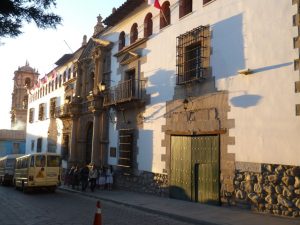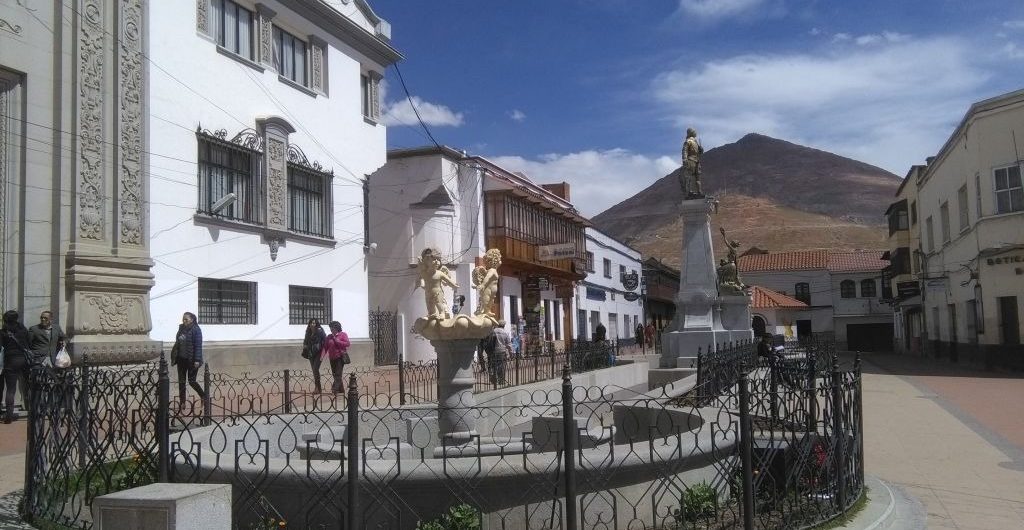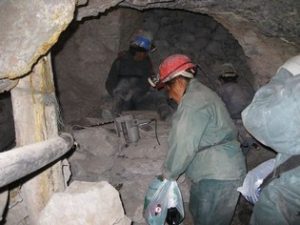Potosí, the most important American City!
Why was Potosí the most important city
Historical seen the Bolivian city of Potosí and its Cerro Rico Silver Mines are without doubt the most important influences in South America history. But the mines and city of Potosí are now almost like a forgotten movie star, famous in its own time, but forgotten by new generations… Hopefully this article can help Potosí and its mines to gain back some of their fame.
History of Potosí and its silver mines
In pre-Hispanic times the current province of Potosí was mainly inhabited by ethnic groups called Charcas, Chullpas and Aymara. These cultures lived from agriculture and selling ceramic pottery and jewelry made from silver.
When the ethnic group of Quechuas, better known as Inca’s, invaded the highlands of Bolivia around 1460 D.C., they were drawn to the areas of Porco and Potosí for its abundance of silver.
Aware that the mountains in this area contained valuable minerals, the Inca’s thought of ways to be able to exploit these natural riches to the max.
The first mining method the Inca’s established in the silver mines of Porco was called “Mita”. Mita is basically a different name for slavery labor and it consisted in obligating the indigenous population of Bolivia (by then named Tawantinsuyo, or the Inca Kingdom of the 4 Winds) to work in the mines of Porco.
According to local legends the Inca’s also wanted to open a mine in Súmaj Orco (which means Beautiful Mountain in Quechua), but when they started digging they heard a booming loud voice coming from the mountain. Supposedly this voice told them that they were not allowed to excavate this mountain, because its content belongs to others.
The Inca’s were superstitious and with the rich minerals found in the mines of Porco, there was no real need to excavate Súmaj Orco. So the Inca’s left this mountain alone.
However even avoiding the possible curse of Súmac Orco, the Inca’s were still not able to enjoy much of their new found wealth.
In 1532 the Spanish General Francisco Pizzaro captured the Inca Leader Atahualpa in Cajamarca and demanded a ransom of one room filled with gold and 2 rooms filled completely with silver. Even after those payments were made, Atahualpa wasn’t released. A few years later, around 1539, the younger brother of Francisco, Gonzalo Pizarro arrived in the area of what’s now called the department of Potosí. He found the silver mines of Porco and heard stories about Súmaj Orco. But when Gonzalo went to the mountain, he didn’t manage to find any silver and gave up.
About how the Spanish finally discovered the rich silver veins, there are different legends. The two most common legends both talk about the local farmer Diego Huallpa who stumbled upon a very rich silver vein while he walked his lama’s.
With his friend Chalco they decided to mine this vein in secret, but his friend betrayed him and informed the Spanish, hoping for a big reward, without having to do the heavy work.
In April 1545 the Spanish Juan de Villarroel was the first conquistador to actually mine this rich silver vein. Not much later he re-named the mountain to be called Cerro Rico, which means “Rich Mountain”.
Once the news was out about this mountain full of minerals, very quickly a chain reaction of events followed!
Potosí
There are different theories about the source of the name Potosí with many of them referring to the sound that the mountain made when the Inca’s tried to mine it. According to those legends a word similar to “potocsi” means “explosion” in Quechua. But the existence of this word and its meaning is not clear.
Others say that Potosí comes originally from the 2 Ayamara words “putukh” and “putuha”, which mean: “making noise” and “to damage”, which would then refer directly to the mining activities in the mountain. But also those words are hard to proof.
Fact is that the name and word “Potosí” on its own quickly became synonym to wealth. Even nowadays the Spanish phrase “Vale un Potosí”, still means that something has a very high value.
 Cerro Rico, silver mine
Cerro Rico, silver mine
The fame of Cerro Rico quickly spread over South America and into Europe, encouraging many different people to travel the long and hazardous route into the dry and harsh landscape of the Andean Alti Plano, in search of a wealthy and better life.
Harsh living conditions
More interested in mining than in establishing cities, the first pioneers quickly settled in the region, occupying native homes and improvising huts in the driest areas of Potosí.
In their excitement at having found so much silver, the new colonists had never taken it upon themselves to carry out the official city foundation ritual.
They spend years in “urban” chaos until finally Francisco de Toledo, the Viceroy of Peru, decided to try to organize this new colony. In 1572 he officially declared the founding of the Villa Imperial de Potosí and ordered to build a Spanish Mint to process the silver.
Toledo organized the town as best as he could, not being able to follow the customary Spanish designs. Instead he drained the swamp that covered much of the area to make the city more inhabitable and instituted the “mita” system, which he copied from the Incas, introducing the use of mercury (a toxic element) to purify the mineral in its raw form. His actions cost the lives of thousands of “mitayos” (enslaved indigenous miners)…
Potosí needed a lot of water, for consumption by its growing population, for work in the mines and to power the mills to ground the silver ore. But water was scarce…
Therefore, Viceroy Toledo decided to take advantage of the springs that ran from the Qari-Qari mountain range which surround the city. Toledo built enormous dikes and dams to redirect the spring- and rainwater from the mountains toward five huge artificial lagoons and over a hundred ore mills. An impressive accomplishment of hydro engineering and architecture!
Over time Viceroy Toledo constructed a total of 32 lakes. Some of these still exist and are known collectively as the Qari-Qari Lagoons.
The Silver Fever
Early 17th century Potosí became home to more than 160.000 inhabitants, making it one of the biggest cities of that era and for sure the biggest capitalist city until that time.
The population was an interesting mix of all types of people: adventurers, soldiers, fugitives, noblemen, friars and priests, artists, academics, gamblers, swordsmen, artisans, miners, traders, and women from all walks of life. Those who didn’t dedicate their time to seeking their fortunes in the mines earned their livings by providing goods and services to those who did.
Of course, a huge Spanish city like that couldn’t exist without proper churches to match the common wealth. The first two churches that were constructed were La Anunciación and Santa Bárbara. These churches were followed by several others until finally there were a total of 36 highly decorated churches and temples.
It is interesting to note that the division of social classes could also be seen in the churches which were divided into “churches for indigenous people” and “churches for Spaniards and creoles (Spaniards born in the Americas)”. Many of these churches are still standing and their façades remain as testimony of their splendor. Convents and seminaries were also built as were great mansions for noblemen and their families, gaming houses, and dance halls for the entertainment of the Spaniards and creoles. No one else was allowed to enter them.
The most notable building of this period became a Spanish Mint, called Casa de la Moneda.
Commissioned by Viceroy Francisco de Toledo, this Casa de la Moneda was designed by the architect Salvador de Vila, who also designed the Spanish Mints of Lima and Mexico. Together these were the only three Mints that were built in the Americas during this period.
The purpose of these Mints was so the raw silver that was found could be processed on site into coins or bars, which were easier to send to Spain. In Spain the royal seal would be imprinted upon them.
Years later the Spanish managed to extract so much silver from Cerro Rico, that the original Casa de la Moneda became too small. The King of Spain then ordered another Mint to be built, using the taxes contributed by the miners to do so.
The construction of the new Casa de la Moneda started in 1751 and was completed in 1773.
This enormous complex is built in the Mestizo Baroque style. It covers over 15,000 square meters and has 200 rooms! It was designed and built under the supervision of two architects named José de Rivero and Tomás Camberos.
The new Casa de la Moneda operated as the Spanish Mint for over two hundred years until it was converted into a museum in 1953. It is still a very recommendable museum to visit.
However it was a long and dangerous trip from Potosí to the Spanish Kingdom, with English and Dutch pirates trying to raid the Spanish galleons, most of the silver from Potosí did make it all the way to Spain. Facilitating the exchange of slaves, fabrics, spices and other goods across the globe and even all the way into China, the silver from Potosí helped fund the Spanish empire’s wars with the British, Dutch, and French – and helped them overcome the Ottomans. The huge wealth that came with this silver and other wealth from the America’s strengthening the influence of the Spanish Kingdom, making it one of the most powerful reigns in the world! The American silver prompted King Philip IV of Spain to proclaim: “In silver lies the security and strength of my monarchy.”
It is even fair to say that the silver found in Cerro Rico has changed the world forever.
However, the silver from Cerro Rico didn’t only bring wealth and prosper. Maybe it is even to the contrary…
The slaves of Potosí
The mita imposed by Viceroy Toledo in Alto Peru caused demographic collapse, earning Cerro Rico a second Quechua name meaning “the mountain that eats men”.
Native Peruvians from hundreds of miles away were forced to travel to Potosí to labour in the mines. They were given the back-breaking task of carrying the daily quota of 25 bags of silver ore, each weighing around 45kg, to the surface. On top, the temperature and humidity differences between the depths of the mine and the surface meant also that pneumonia and respiratory infections were rife.
The notes of one mining boss stated: “If 20 healthy Indians enter on Monday, half may emerge crippled on Saturday.”
Because of these unhealthy and dangerous working conditions, the mines and local settlements in Gran Perú slowly started to run out of cheap labor, forcing the Spanish to import African slaves into Potosí.
According to some estimates the Spanish might have brought more than 30.000 African slaves to the mines of Potosí, many of whom didn’t survive…
While extracting the silver from Cerro Rico caused the deaths of many indigenous and foreign slaves, the silver fever and trading caused its own misery and even deaths…
The downfall of Potosí
Greed proved ruinous and the seemingly unlimited supply of silver fuelled an unsustainable level of spending by the Spanish royals. At one point, during the procession of Corpus Christi in 1658 the city center cobblestones were dug up and replaced with bars of silver all the way to the Recoleto Church. This display of luxury gave rise to legends about the American city whose streets were paved with silver and not cobblestones…
The icy Andean wind continued to spread rumors all over the continent and beyond, about Potosí a city where the streets were covered with silver and its citizens lived like kings.
But despite all these rumors about a city of unlimited richness, the flamboyance city of Potosí is also still located at 4060 m (13320 feet) altitude, in a dry area were almost nothing grows… These natural conditions made live not easy for those who wanted to settle in Potosí, especially for the Spanish who came from a fertile, Mediterranean climate at sea level… The first Spanish boy to survive birth in Potosí was born in 1584, nearly 40 years after the city’s foundation.
Although nature brought the new colonists many challenges, human greed turned out to be even deathlier. During its heyday Potosí was consistently plagued by murderous disputes between the different races, social classes and even royalties.
It’s suspected that over the years thousands of people died during different civil wars, between new arrivals, creoles and the dominant Basque ruling class in Potosí.
In 1628 the Spanish crown received another big blow, when the Dutch Admiral Piet Hein managed to conquer a big part of the famous Spanish Silver Fleet. This huge and very heavily guarded fleet annually transported most of the riches found in the Americas to the Kingdom of Spain. This Dutch victory in return helped the Netherlands in their fight against the Spanish oppressing.
During the late 17th century the huge amounts of Silver coming from the Americas caused inflation of prices in Spain and deflation of the value of silver on the international market. These economic problems in combination with civil wars and natural hazards contributed also to the downfall of Potosí. Its population declined from around 160.000 to less than 60.000 and one of its residents wrote: “Everything is finished. All is affliction and anguish, weeping and sighing. Without doubt this has been one of the greatest downfalls ever.”
Halfway the 18th century the demand for silver went up again and Potosí experienced a new period of abundance, wealth, greed and misery.
At the end of the 18th century this short silver boom was followed by the industrial revolution in Europe. The industrial revolution required a high demand of tin and tin happens to be the second most available mineral in Cerro Rico. Therefore the mining in Potosí moved its focus from silver to tin, providing the city with a more steady income.
At the end of the Second World War the United States started to purchase Bolivia’s tin at bargain prices, causing its economy to go down ones again.
Until present day Potosí and Bolivia haven’t been able to recover from this latest blow and Bolivia belongs now officially to one of the poorest countries in Latin America.
But with a soil full of minerals and a never ending demand for minerals, one day the ‘beggar Bolivia’ could rise to be an important power again…
The current richness of Potosi

Potosí has preserved a great deal of its colonial architecture, narrow streets, many of its sumptuous temples, museums with unique and priceless objects, the Casa de la Moneda, the machinery from the Spanish Mint and, of course, the Cerro Rico.
Even after five centuries of exploitation and the drilling of thousands of tunnels into its bowels, Cerro Rico still continues to produce tin, zinc and even silver.
Tourists who are interested can now also contract a travel agency, or hire a guide and visit some of the mining tunnels, providing Potosí with a new source of income.
On December 7, 1987 UNESCO declared the city of Potosí a Cultural Heritage of Humanity and we highly recommend all tourists who travel to Bolivia to visit the city of Potosí!
Sources for this article:
https://en.wikipedia.org/wiki/Potos%C3%AD
http://www.boliviabella.com/historia-de-potosi.html
https://www.theguardian.com/cities/2016/mar/21/story-of-cities-6-potosi-bolivia-peru-inca-first-city-capitalism

 Cerro Rico, silver mine
Cerro Rico, silver mine
